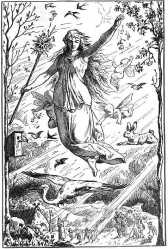[2 / 1 / ?]
Quoted By: >>12477199
Happy Eástre everyone!
https://en.wikipedia.org/wiki/%C4%92ostre
>Ostara, Eástre seems therefore to have been the divinity of the radiant dawn, of upspringing light, a spectacle that brings joy and blessing, whose meaning could be easily adapted by the resurrection-day of the Christian's God. Bonfires were lighted at Easter and according to popular belief of long standing, the moment the sun rises on Easter Sunday morning, he gives three joyful leaps, he dances for joy ... Water drawn on the Easter morning is, like that at Christmas, holy and healing ... here also heathen notions seems to have grafted themselves on great Christian festivals. Maidens clothed in white, who at Easter, at the season of returning spring, show themselves in clefts of the rock and on mountains, are suggestive of the ancient goddess.
>In the second volume of Deutsche Mythologie, Grimm picks up the subject of Ostara again, connecting the goddess to various German Easter festivities, including Easter eggs:
>But if we admit, goddesses, then, in addition to Nerthus, Ostara has the strongest claim to consideration. To what we said on p.290 I can add some significant facts. The heathen Easter had much in common with May-feast and the reception of spring, particularly in the matter of bonfires. Then, through long ages there seem to have lingered among the people Easter-games so-called, which the church itself had to tolerate: I allude especially to the custom of Easter eggs, and to the Easter tale which preachers told from the pulpit for the people's amusement, connecting it with Christian reminiscences.
https://en.wikipedia.org/wiki/%C4%92ostre
>Ostara, Eástre seems therefore to have been the divinity of the radiant dawn, of upspringing light, a spectacle that brings joy and blessing, whose meaning could be easily adapted by the resurrection-day of the Christian's God. Bonfires were lighted at Easter and according to popular belief of long standing, the moment the sun rises on Easter Sunday morning, he gives three joyful leaps, he dances for joy ... Water drawn on the Easter morning is, like that at Christmas, holy and healing ... here also heathen notions seems to have grafted themselves on great Christian festivals. Maidens clothed in white, who at Easter, at the season of returning spring, show themselves in clefts of the rock and on mountains, are suggestive of the ancient goddess.
>In the second volume of Deutsche Mythologie, Grimm picks up the subject of Ostara again, connecting the goddess to various German Easter festivities, including Easter eggs:
>But if we admit, goddesses, then, in addition to Nerthus, Ostara has the strongest claim to consideration. To what we said on p.290 I can add some significant facts. The heathen Easter had much in common with May-feast and the reception of spring, particularly in the matter of bonfires. Then, through long ages there seem to have lingered among the people Easter-games so-called, which the church itself had to tolerate: I allude especially to the custom of Easter eggs, and to the Easter tale which preachers told from the pulpit for the people's amusement, connecting it with Christian reminiscences.

